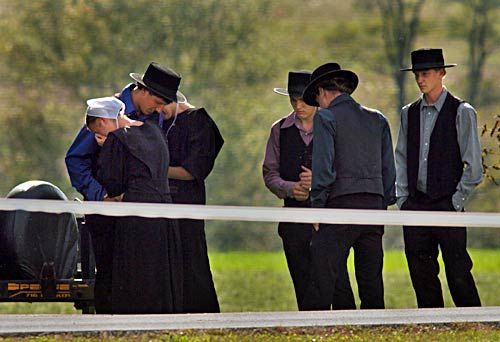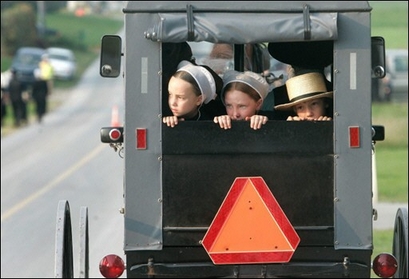 The Amish are not known as easy interviews. In fact, many do not like to talk to journalists at all and, when they talk, they often speak German.
So Baltimore Sun reporter Julie Scharper's feature story about the one-year anniversary of the Nickel Mines, Pa., school massacre is fascinating on several levels. For one thing, it is full of the kind of simple, clear, unaffected words that one would expect from Amish believers. Thus, the headline: "Sharing their grief: In plain words, Amish detail a year spent mourning, healing after shootings at school."
The Amish are not known as easy interviews. In fact, many do not like to talk to journalists at all and, when they talk, they often speak German.
So Baltimore Sun reporter Julie Scharper's feature story about the one-year anniversary of the Nickel Mines, Pa., school massacre is fascinating on several levels. For one thing, it is full of the kind of simple, clear, unaffected words that one would expect from Amish believers. Thus, the headline: "Sharing their grief: In plain words, Amish detail a year spent mourning, healing after shootings at school."
So how did she get them to talk?
She didn't. This is one case where the reporter found another door into this story -- an old-fashioned, ink-and-paper door.
As members of a faith that prizes humility and modesty, the victims' families and friends have turned their backs on the public grieving that is so much a part of modern American culture, choosing instead to heal their wounds in private. School is closed today, and last week the Amish weren't discussing the anniversary with strangers.
But over the past year, members of the community have shared their grief on paper. In scores of letters to the weekly Amish newspaper Die Botschaft they have relived that day and reflected on the struggles of the past 12 months. Interspersed with news of the weather and crops, the plain-worded letters tell of piercing grief, small triumphs and deeply rooted faith. Taken together, they provide unique insight into the ways that residents of Nickel Mines have mourned their daughters while summoning the spiritual strength to move forward.
Here is some additional information on the remarkable source that made this story possible:
Die Botschaft -- "The Message" in German -- compiles the letters in an 80-page newspaper, relying on dispatches from several hundred "scribes" in Amish districts throughout the United States, Canada and Mexico. The correspondents' accounts are arranged in neat columns without pictures.
Before the tragedy, the letters from here skipped through news from the church districts -- religious services, visitors, births, marriages and the occasional notable meal -- while weaving in humorous anecdotes. After the shootings, they grew more personal.
In one, [Enos] Miller described being at his job the morning of Oct. 2 when he saw helicopters hovering near his home. He called a neighbor, who told him about the shooting. His first thought: "Oh, no, the two granddaughters," he wrote in the understated prose that characterizes the newspaper. "After I hung up, the strength seemed to drain from me. But somehow I could keep going."
 As you would expect, the article contains quite a bit of information about the Amish community's warm, forgiving treatment of the family of Charles Carl Roberts IV, the gunman whose rampage ripped at the young heart of their community.
As you would expect, the article contains quite a bit of information about the Amish community's warm, forgiving treatment of the family of Charles Carl Roberts IV, the gunman whose rampage ripped at the young heart of their community.
But the newspaper letters also offered insights into the lives of the children who survived, which is a side of this drama previously kept private. Four of the girls were quickly back in school, even as they continued to recover from their wounds. But that is not the end of that story:
A fifth girl, 7-year-old Rosanna King, suffered a serious brain injury. She was removed from life support within two days of the shooting and was expected to die.
Instead, she has become a living miracle for the Amish, who found inspiration as she progressed from bed to wheelchair and began to recognize family members and laugh out loud. But progress has been slow. ...
One writer wondered whether the community could do more for her.
"Maybe we are not praying hard enough," wrote Yonie Esh of Georgetown. He seemed to hesitate at the idea. "But then again we want to say, 'Thy will be done.' If I write something that I should not, I do apologize. I certainly do not want to offend anyone."
When Rosanna returned to church for the first time after the shooting, the moment generated considerable excitement.
"She doesn't talk ... but so precious to have her around," wrote Susanna Stoltzfus.
This is a very simple story, based on these letter from inside a community that prefers to keep its sorrows and joys private. The simplicity is what makes the story so powerful.
Life continues in Nickel Mines. It was fortunate that the Sun found a way to take readers inside that story, without violating the lives of those who are living it. This is must reading.
